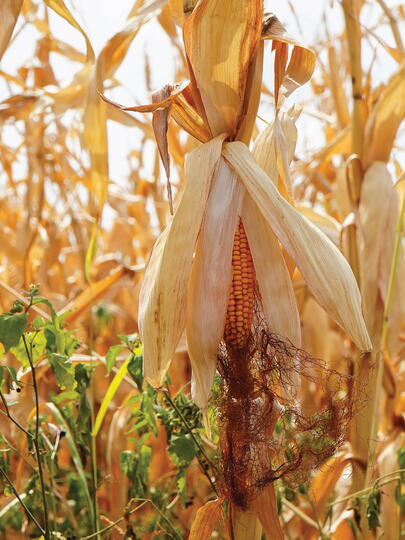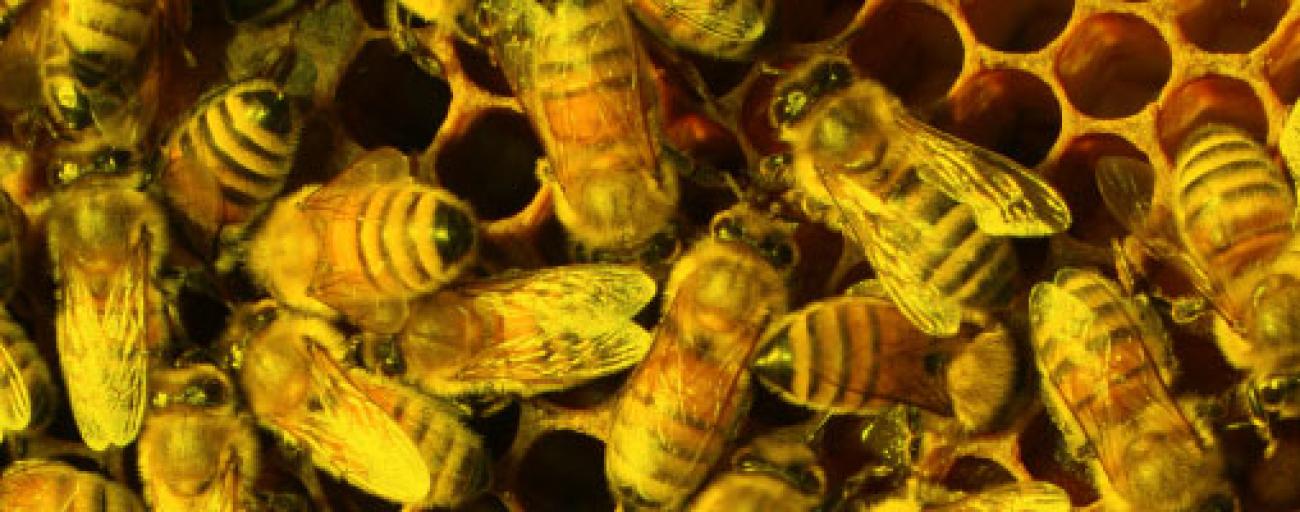Plight of the Honey Bee
The ongoing decline of honey bees in the developed world is a serious threat to food security, yet there is no consensus on the cause and scientists are still searching for a solution.
In early July, amidst the pungent peak of blackberry blooms, a swarm of bees the size of a baseball landed on a branch in a cottonwood tree next to a research plot at UBC Farm. It was soon captured and housed in a wooden-framed hive, but a few weeks later the colony is still small – nowhere near the biomass needed to survive the winter. “So I will have to do something,” says Allen Garr, the beekeeper who tends the farm’s six hives.
Suited in a bee helmet and leather gloves, Garr pries open the top super of a neighbouring hive using a piece of metal that looks like a boomerang. Inside the cells of the frame he points out cap brood, which will emerge as bees within the week, and larvae that are four or five days old. But what he’s looking for are eggs, evidence of a queen. Depending on her genetics and how much pollen she is being fed by the worker bees, a good queen can lay up to her weight in eggs every day – about 2,500. “Okay, Tootsie, where are ya?” Garr asks, but judging from the lack of eggs he suspects this colony lost its queen a week ago. He decides to combine the two colonies into one strong enough to survive winter, but then he spots her. “She just isn’t laying very well,” he sighs. The smaller colony will have to fare on its own. “If the [other bees] detect a queen that doesn’t smell like their own, they’ll kill her,” explains Garr.
He walks back to his truck, pulls off his leather gloves, replaces them with a pair of rubber ones, and gets out a bucket of pads like the ones that come under the meat you buy at the supermarket. Instead of blood, these have been soaking up formic acid for an anti-mite treatment he is about to apply.
The Vital Bee
“Beekeeping has become an extraordinarily complex process of animal husbandry,” says Paul van Westendorp, British Columbia’s provincial apiarist. More than fifty years have passed since van Westendorp became interested in bees. He can still conjure the aroma of wax on that warm summer day in Holland when his grade three teacher took his class to a local apiary. After keeping his own hives as a teen, he moved to Canada for an undergraduate degree in agricultural sciences at UBC. He has done apicultural research in northern Alberta, apicultural development in Africa and has been the provincial apiarist in BC since 1990. Bees, according to van Westendorp, are the spark plug of agriculture. “Without them,” he says, “we simply cannot function.”
Approximately 25,000 species of bees have been identified, with at least 40,000 still to be catalogued, but our food system has become entirely dependent on one species to pollinate crops: the Western honey bee (Apis mellifera). Ironically, this honey bee is not even native to North America; it was brought here by European colonizers. But over the last 40 years the total acreage of crops in North America that depend on this single pollinator has increased substantially (think about the fruit now available year-round – from strawberries to watermelons.) At the same time, there has been a sharp decline in the number of beekeepers, who in turn are noticing an increasing number of pathogens affecting their hives. “What we have are two opposing trends,” says van Westendorp, “an increased demand for crop pollination and a decline in managed pollinators.” Two questions follow that observation: what has happened to the bees and what can we do to fix it?
Bees, according to van Westendorp, are the spark plug of agriculture. “Without them,” he says, “we simply cannot function.”
The Industrial Bee
More than a third of current global agriculture production depends on the honey bee for pollination. While some plants, such as grapes, are self-fertile, many others, such as apples and blueberries, require an insect to reproduce. Large-scale mono-cropping of pollination-dependent plants means pollinators need to be brought to the fields. And they don’t get there by beating their wings.
In the United States, colonies of honey bees are shipped on flatbed trucks from the wintering grounds of southern Texas, Florida and Mississippi to California in order to pollinate the sea of peach blossoms that will become almonds. At an estimated $2 billion a year, almonds are the most valuable cash crop in the US. The bees then travel north to Oregon and Washington State to pollinate blueberries and cranberries, as well as apples in the Yakima Valley. This is followed by a road-trip to the Dakotas for clover and canola before being brought back to Texas to pollinate the tiny two-centimetre yellow blossoms on watermelon vines.
“We have a far more mechanized and highly developed agricultural industry than anywhere in the world,” says van Westendorp. “We have cranked up production to such a level that it is a fine-tuned machine.” In British Columbia, where the first hives arrived by ship in 1858, honey bee pollination is now responsible for more than $160 million per year in agricultural production. In comparison, the total market value of hive products, including honey and beeswax, comes in at a paltry $8 million. Nationwide, pollination contributes an estimated $750 million to agricultural production, and in the US the number jumps to over $15 billion. Globally, enhanced crop pollination accounts for $285 billion of farm receipts. “As soon as one component is missing,” says van Westendorp, “a whole bunch of other things go sequentially in the wrong direction.”
The Missing Bee
Worker bees started to decrease in number in the spring of 2006. In early 2007 news broke of Colony Collapse Disorder, and the public was warned that honey bee die-off threatened food security. Most of us became aware for the first time just how much we rely on honey bees. Canadian colonies were hit with a loss of about 35 per cent in the winter of 2008-2009. By 2010, US colony losses were estimated at 50 per cent. The number of missing bees has been equated to the number of human deaths during the Black Plague, and yet the cause of Colony Collapse Disorder (a name and concept still contested amongst scientists) has not yet been determined. What we do know is that it has only been noted in the most developed countries.
In less developed countries, there has not been a substantial loss of colonies. The key to this, for van Westendorp, is agricultural practice. In Africa, subsistence farmers have mastered the technique of inter-cropping, whereby tall vegetation, like bananas, is mixed in with smaller shrubbery, like yucasava, and the ground is covered by plants like beans and peas. Most importantly, there are wild pollinators.
By comparison, van Westendorp says to imagine driving through the Fraser Valley in the spring when the highbush blueberry, which brings in $100 million annually, has started to flower. Just one acre of these cultivated blueberries produces 4.5 to 5 million flowers. Relying on wild pollinators in this mono-cultural setting is impossible. Densely repetitive crops leave no space for fallen trees where a native pollinator might rest or a swarm might make a home. Intense production methodologies like mono-cropping create unnatural environments, and bees are simply not designed to be carted about on the backs of trucks, feeding from limited floral sources. Though it is hard to prove, van Westendorp says it is widely accepted that this type of management regime may result in acute dietary or nutritional deficiencies.
Humans have been managing bee colonies for more than 7,000 years, but in the 1850s an ample understanding of honey bee reproduction and genetics allowed beekeepers to start breeding for desirable traits. Nowadays, beekeepers select based on four criteria: honey production, disease resistance, gentleness, and winter hardiness. Over the years, this selection process has changed the bee’s exoskeleton, nervous system, digestive tract, and collective social behaviour. But breeding for desirable traits does not always solve problems. Breeders may be selecting from an ever narrower pool of genetics, says van Westendorp, and the question often raised is whether we have narrowed down that genetic pool to the point where it has become more vulnerable to the onslaught of different climatic regimes or pathogens.
Allen Garr tends the bee colonies at UBC Farm (Photo: Teresa Goff)
“Hi, girls, me again,” Garr says through the respirator he has just put on to protect himself from the fumes of formic acid. He opens a new hive; a swarm flies up and hovers. He peels off an old pad and applies a new one, the third in a series of seven treatments. “When their bums stick in the air it means they are pissed off,” says Garr, pointing to the bees still on the hexagonal cells of the frame. “You can tell the moods of bees even though they are little insects,” he says, squeezing the bellows of a blue tin smoke can to calm them. The bees don’t like the formic acid, which has an assaulting scent. Through the respirator, which makes him sound like a soft-spoken Darth Vader, Garr says that he tries to make sure the acid doesn’t touch the bees. If it does, it will kill them. As a rule, beekeepers try not to kill their bees. They take care of them, lovingly, attentively. Bees are the only insect of the order hymenoptera that we cultivate instead of kill. All other socializing insects get the stomp, swat or spray. We destroy the hives of ants and wasps with equal aggression. For bees that bear honey, we build wooden frames and wage war against pathogens using formic acid, originally distilled from the body of ants (Latin name: formica).
The formic acid on the pads Garr is using was probably produced commercially, somewhere in Germany or China. When it turns to gas, it permeates the hive and kills two types of mites: a tracheal mite, which causes the bee to suffocate, and the varroa mite. Of the two, the varroa mite is more serious. It causes all kinds of stress on the colony and injects viral material straight into the body cavity of either brood or adult bees. These parasitic mites are complex organisms and need to be fought with very special tools.
The Tools
With the sequencing of the bee genome in 2006, researchers have been able to study the bee from molecule to colony. Every organism has a genome that contains all the biological information needed to build and maintain it, and genome sequencing is the process of figuring out the order of that biological information. Proteomics is considered the next step in the study of biological systems.
“Proteomics is to proteins what genome sequencing is to genes,” explains Leonard Foster, an associate professor of Biochemistry at UBC. Foster was recently awarded a grant by Genome Canada to facilitate a three-year study applying a selective breeding program to the honey bee. The aim is to increase certain bee behaviours that are known to coincide with better disease resistance. Since there is a direct link between these behaviours and the type and quantity of protein present in cells, Foster will measure the molecular fingerprints of 500 different bee populations and compare them with those of disease-resistant bees identified during a previous study. Populations with the closest match will be selected for breeding. His team will use a technology called mass spectrometry to analyze bee samples for the types and quantity of protein present. Understanding which proteins are involved in specific behaviours will allow Foster to isolate beneficial ones.
The advantage of using molecular techniques to select breeding stock is accuracy – leading to bigger improvements in bee health following each cycle – and also speed. “Without the aid of molecular techniques it takes a year to go through one breeding cycle,” says Foster. “But with them we might be able to do a few cycles per year.” By 2013, Foster will be ready to field test the selectively bred bees to see if they are less prone to disease.
With agricultural production at peak pitch and pathogens attacking hives to the tune of the Black Plague, the top speed solution offered by Foster is invaluable. “At the end of the tunnel, he will not give us the magic bee,” says van Westendorp, “but rather a tool that allows us to find that particular strain of bee which is most resistant to disease.”
With the sequencing of the bee genome in 2006, researchers have been able to study the bee from molecule to colony.
Back at the farm, Garr is packing up and moving on to one of the other locations where he keeps bees. He takes care of about 20 hives, depending on how many are lost over winter or whether he catches a swarm and gains a colony. When Garr had a broken leg and was at home recovering, a friend caught a swarm on the west side. Instead of trucking it back to East Vancouver where he lived, he left it on the back porch of Garr’s Kitsilano home. Since then, two rooms in Garr’s basement have become overrun; one for the honey extractor, jars and lids, the other for building and storing the honey supers, standards and wooden frames. Over the years, he has come to recognize weather patterns and notice if his neighbours are spraying pesticides. “It kind of turns you into an environmentalist,” says Garr. “The girls showed me the way.”
The girls may show many more people the way. The economic heft of agricultural production that this tiny insect bears weighs a lot more than honey. While it is too late to turn the agricultural clock back to a time when we didn’t depend so much on one species of bee, a survey of the current situation helps us understand the pressing sustainability issues in our food system. “We often lose sight of the interconnectedness between living components and all the parts that fit together,” says Paul van Westendorp. This wisdom is not lost on Anelyse Weiler, a recent graduate of UBC’s Global Resource Systems program in the Faculty of Land and Food Systems. Aside from being the communications coordinator at the UBC Farm, she is working to help improve bee forage by planting native and non-native species that bloom throughout the growing season. “One of the mottos we have for ecological integration at the farm is the idea that no one thing does just one thing,” says Weiler. “Bees are a perfect illustration of that simple concept.”
UBC Farm: A Pollinator’s Paradise
By Anelyse Weiler, BSc’11,
UBC Farm Communications Coordinator
At the farm, we manage a rich diversity of habitats in order to support critical ecosystem services such as pollination. This diversity ranges in scale from entire landscapes to individual genes, thus encompassing a 90-year old coastal hemlock forest, 250 varieties of organic crop, and the 70 types of heritage apple pollinated by bees in our student-initiated orchard. For the past several years we have been establishing wildlife hedgerows and other natural habitats, integrating them into areas of intensive field production.
Habitat loss and urbanization have harmed bee populations by reducing the abundance of flowers for food. We have been working to expand “insectary” plantings with the help of undergraduate student researchers and community volunteers. Our goal is to ensure that both the farm’s honey bees and indigenous bees have access to a suite of floral nectar and pollen sources throughout the growing season. We also keep the bees’ needs in mind when sowing cover crops in the fall. Cover crops are primarily used to protect soil from rain, build organic matter and add nitrogen, but flowering cover crops such as clover species and phacelia also happen to be excellent sources of food for bees and butterflies.
These efforts to improve bee forage don’t need to end at the farm; anyone with a garden can help. By planting colourful and fragrant species of flowers attractive to bees, gardeners can have a positive impact on the health of local pollinators. It is particularly important to include native flowers such as goldenrod, Oregon grape, lupines and pearly everlasting. This season, we established a community partnership with the Environmental Youth Alliance through its Pollinator’s Paradise program. Local high school students built the farm two “condos” for the native orchard mason bee. These simple bee houses can be built or bought and affixed to the outside of a building, meaning apartment dwellers can do their bit, too.
The UBC Farm welcomes members of the UBC and broader community who are interested in teaching, research and volunteer opportunities. See the website for details (www.landfood.ubc.ca/ubcfarm). Updates on academic initiatives, farm markets and quirky site happenings are posted on Facebook (Centre for Sustainable Food Systems at UBC Farm) and Twitter (@ubcfarm).



































